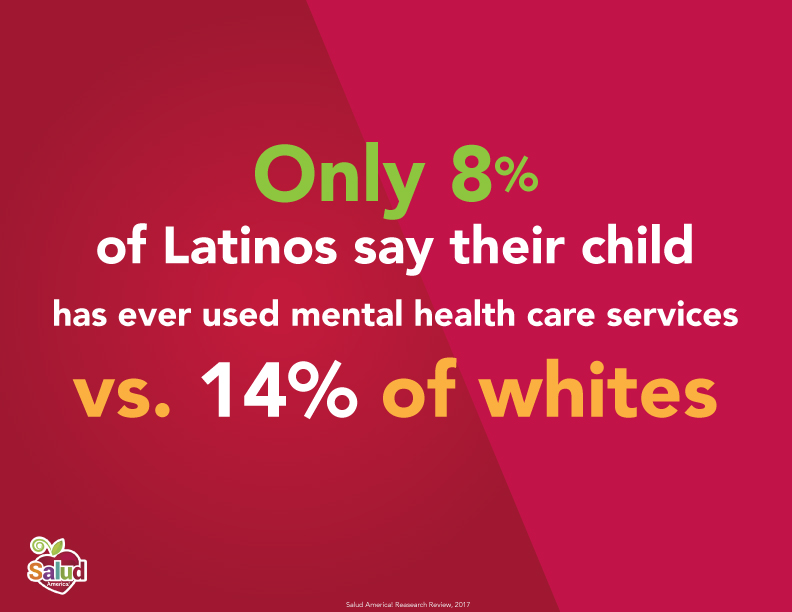
Share On Social!
This is part of our Mental Health & Latino Kids: A Research Review »
Latino kids have unmet mental health care service needs
Latino children and other racial/ethnic minority youth are less likely to receive the necessary mental health care compared with their white peers.8,9
A cross-sectional study of data from the National Survey of Child and Adolescent Well-being (NSCAW) addressed mental health issues among Latino children ages 2-14 who were living with at least one biological parent (31% were preschool aged 2-5 years, 45.9% were school-aged 6-10 years, and 23.3% were adolescent 11-14 years).
Of the three groups, adolescents had the highest rate of clinical need for mental health services at 60.9 percent, followed by school-aged children (38.3%) and preschool children (37.2%).
However, the rate of mental health service use was also highest among adolescents: 39.1 percent reported having received mental health services in the past year, compared to school-aged children (17.3%) and preschool children (10.8%).
The authors found that preschool aged children had the highest unmet need for mental health services; of the preschool children who scored within the clinical range on the Child Behavior Checklist (CBCL), 77.3 percent had not received any mental health services in the past year, compared to 75.6 percent for school-aged children and 57.9 percent for adolescents.
Interestingly, preschool aged children with parents born in the U.S. were significantly more likely to have unmet mental health needs compared to those with immigrant parents (95.2 percent versus 55.6 percent), but the reverse was true of adolescents, with 73.6 percent of those born to immigrant parents having unmet mental health needs, compared to 41 percent of those with U.S.-born parents.10
Latino kids lack access to mental health care services
A cross sectional study of data from the 2006-2012 Medical Expenditure Panel Surveys (MEPS) found that Latino children had about half of the outpatient mental health visits that their white peers had.
After controlling for demographics, mental health impairment, and insurance status, Latino children had lower hospitalization rates for mental illness compared to white children, and they had lower rates of substance use disorder counseling.11
 Fewer minority parents report that their black (6%) and Latino (8%) children had ever used mental health care services, compared to white children (14%).
Fewer minority parents report that their black (6%) and Latino (8%) children had ever used mental health care services, compared to white children (14%).
Fewer black and Latino children with recent symptoms of attention-deficit/hyperactivity disorder, oppositional defiant disorder, and conduct disorder had ever utilized services compared with white children.12
Many factors influence Latino kids’ receipt of services
Le Cook, et al., conducted a secondary analysis of data from a study of mental health-related communication skills training for medical assistants (MAs).
The study took place at a federally qualified health center (FQHC) in Washington, D.C. that served a majority Latino population. The MA training consisted of three one-hour sessions, where the MAs learned to greet and orient patients, obtain relevant information from the patients, respond to the patients’ concerns, and identify the reason for the patients’ visits. All MAs spoke Spanish; the pediatricians at the FQHC were not native Spanish speakers, though most did speak Spanish with their patients.43
The secondary analysis included Latino parents and youth (18 months to 16 years) seeking pediatric care who were recruited and consented at the health center when they arrived for their visit. The parents were asked whether they had spoken to an MA or a doctor about their child’s behaviors, feelings, academic performance, peer relationships, and family problems, and answers to the questions were tallied based on a 6-point scale. Study measures included acculturation, mental health, and income barriers.
Before adjusting for sociodemographics, parents who had been in the U.S. for 10 years or more were more likely than those who had been in the U.S. for 0-5 years to discuss their own stress issues with an MA, and parents in the U.S. from 6-10 years and greater than 10 years were also more likely to discuss how their child was performing in school.
One-third of parents in the study sample reported discussing mental health problems with an MA, while two-thirds discussed these problems with a doctor.
After adjusting for sociodemographic variables, a significant positive correlation was noted between the amount of time parents had lived in the U.S. and the willingness of the parents to communicate child and parent stress issues with an MA.
In addition, parent-child language discordance negatively predicted discussion of these problems with an MA.43
In an article on cultural considerations in minority youth with psychosomatic problems, Goldston et al. identified several factors that influence help-seeking among Latino youth, noting that newly immigrated Latinos are much less likely to seek help due to fear of deportation.
English-speaking, U.S.-born Latino youth, however, are more likely than their recently immigrated peers to attempt suicide; the authors suggest that this group may have a more difficult time receiving proper help if their non-English-speaking parents are not able to effectively communicate with non-Spanish-speaking healthcare professionals.
Despite the higher rates of suicide attempts among Latino youth, these children are less likely to be identified as suicidal and are thus also less likely to receive crisis intervention services than are other minorities.5
In their cross-sectional review of data from the 2006-2012 MEPS, Marrast et al. observed that, compared to non-Latino white (NLW) children, minority children (including Latinos) with behavioral or psychiatric problems are more likely to receive in-school punishment and incarceration rather than mental health care. NLW youth were also more likely to receive substance use disorder counseling, with 24/1000 visits, while Latino youth accounted for only 8.5/1000 visits.11
Both Goldston et al. and Marrast et al. noted structural barriers, including the lack of child psychologists practicing in low-income areas.5,11
Umpierre et al. conducted focus groups for 36 Latino caretakers of children who had been identified as having conduct difficulties in school.
During these focus groups, the study authors identified five themes: caretakers considered school a source of tension; caretakers felt as though school staff was blaming them for their children’s conduct issues; mental health referrals for their children were a source of tension; caretakers felt uncomfortable discussing personal family issues in a clinic setting; and they felt a sense of shame in having a child with conduct problems.
The authors also noted that, when describing children’s mental health problems, the caretakers often used the terms loca and locura (crazy), which started a discussion about the differences in how mental health issues are discussed in the U.S. versus the caretakers’ countries of origin.44
More from our Mental Health & Latino Kids: A Research Review »
- Introduction & Methods
- Key Research Finding: Issues facing Latino kids
- Key Research Finding: Latino kids access to care (this section)
- Key Research Finding: The migration experience
- Key Research Finding: Latino family issues
- Key Research Finding: Latino community and school issues
- Key Research Finding: Programs with promise
- Key Research Finding: Policies with promise
- Policy Implications
- Future Research Needs
References for this section »
5. Goldston, D. B. et al. Cultural Considerations in Adolescent Suicide Prevention and Psychosocial Treatment. Am. Psychol. 63, 14–31 (2008).
8. Chetty, R. et al. How Does Your Kindergarten Classroom Affect Your Earnings? Evidence from Project Star. Q. J. Econ. 126, 1593–1660 (2011).
9. Kim, M. & Garcia, A. R. Measuring Racial/Ethnic Disparities in Mental Health Service Use Among Children Referred to the Child Welfare System. Child Maltreat. 21, 218–227 (2016).
10. Dettlaff, A. J. & Cardoso, J. B. Mental health need and service use among Latino children of immigrants in the child welfare system. Child. Youth Serv. Rev. 32, 1373–1379 (2010).
11. Marrast, L., Himmelstein, D. U. & Woolhandler, S. Racial and Ethnic Disparities in Mental Health Care for Children and Young Adults: A National Study. Int. J. Health Serv. 46, 810–824 (2016).
12. Coker, T. R. et al. Racial/Ethnic Disparities in the Mental Health Care Utilization of Fifth Grade Children. Acad. Pediatr. 9, 89–96 (2009).
43. Lê Cook, B., Brown, J. D., Loder, S. & Wissow, L. Acculturation Differences in Communicating Information about Child Mental Health Between Latino Parents and Primary Care Providers. J. Immigr. Minor. Health Cent. Minor. Public Health 16, 1093–1102 (2014).
44. Umpierre, M. et al. Understanding Latino Parents’ Child Mental Health Literacy: Todos a bordo/All Aboard. Res. Soc. Work Pract. 25, 607–618 (2015).
Explore More:
Healthy Families & SchoolsBy The Numbers
142
Percent
Expected rise in Latino cancer cases in coming years



